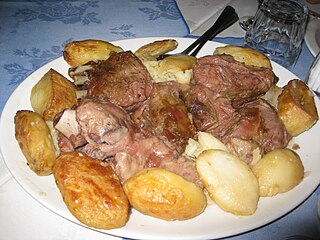
Lamb, hogget, and mutton, generically sheep meat, are the meat of domestic sheep, Ovis aries. A sheep in its first year is a lamb and its meat is also lamb. The meat from sheep in their second year are hogget. Older sheep meat is mutton. Generally, "hogget" and "sheep meat" are not used by consumers outside New Zealand, South Africa and Australia with the exception of the Navajo people in the American Southwest, who consume mutton as a staple part of their diet. Historically, Navajo sheep ranching has been regulated by the Federal Government due to habitat destruction caused by sheep overgrazing.

Offal, also called variety meats, pluck or organ meats, is the organs of a butchered animal. The word does not refer to a particular list of edible organs, which varies by culture and region, but usually excludes muscle. Offal may also refer to the by-products of milled grains, such as corn or wheat.
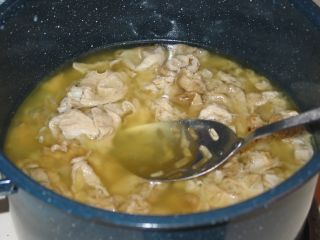
Chitterlings are a culinary dish usually made from the large intestines of a hog, although the intestines of cattle and other animals are sometimes used.
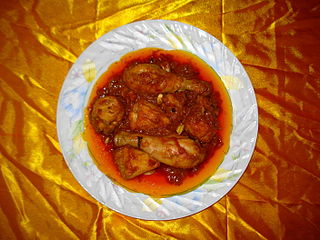
Korma or qorma is a dish originating in the Indian subcontinent, consisting of meat or vegetables braised with yogurt (dahi) or cream, water or stock, and spices to produce a thick sauce or gravy.

Biryani is a mixed rice dish originating among the Muslims of the Indian subcontinent. It is made with Indian spices, rice, and meat, and sometimes, in addition, eggs or vegetables such as potatoes in certain regional varieties.
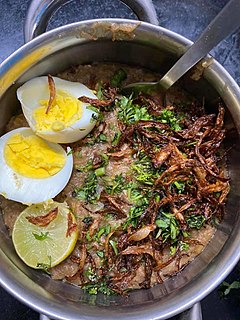
Haleem is a type of stew popular in the Middle East, Central Asia, the Indian subcontinent. Although the dish varies from region to region, it optionally includes wheat or barley, meat and lentils. Popular variations include keşkek in Turkey, Iran, Afghanistan, Tajikistan, Uzbekistan, Azerbaijan and northern Iraq; hareesa in the Arab world and Armenia; halim in Bangladesh and West Bengal, India; khichra in Pakistan and India.
Norwegian cuisine in its traditional form is based largely on the raw materials readily available in Norway and its mountains, wilderness, and coast. It differs in many respects from continental cuisine through the stronger focus on game and fish. Many of the traditional dishes are the result of using conserved materials, necessary because of the long winters.

Khash is a dish of boiled cow or sheep parts, which might include the head, feet, and stomach (tripe).

Hyderabadi biryani, also known as Hyderabadi dum biryani, is a style of biryani from Hyderabad, India made with basmati rice and goat meat and cooked with the dum pukht method. Originating in the kitchens of the Nizam of Hyderabad, it combines elements of Hyderabadi and Mughlai cuisines. Hyderabad biryani is a key dish in Hyderabadi cuisine.
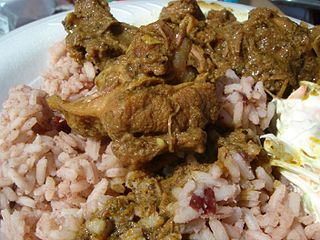
Curry goat is a curry dish prepared with goat meat, originating from the Indian subcontinent and Southeast Asia. The dish is a staple in Southeast Asian cuisine, Caribbean cuisine, and cuisine of the Indian subcontinent. In Southeast Asia, the dish was brought by Indian diaspora in the region, and subsequently has influenced local cuisine. This dish has spread throughout the Caribbean and also the Indo-Caribbean diaspora in North America and Europe.
Fauna of Azerbaijan or animal kingdom of Azerbaijan refers to the diversity of various types of animals, which inhabit and populate a defined ground or water area in Azerbaijan.
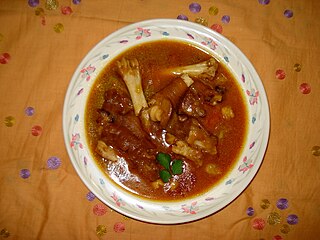
Paya is a traditional food from the Indian Subcontinent.

Pachadi refers to a traditional South Indian fresh pickle served as a side dish. Broadly translated, it refers to food which has been pounded. In Andhra Pradesh, Telangana, Karnataka, Kerala and Tamil Nadu, pachadi is a side dish curry similar to the North Indian raita, and is made with vegetable, yoghurt, coconut, ginger and curry leaves and seasoned with mustard. Pachadi generally is a hot or mildly spiced coconut, green chillies, red chillies and yogurt-based dish made with seasonal vegetables or fruits.

Goat meat or goat's meat is the meat of the domestic goat (Capra aegagrus hircus). The common name for goat meat is simply "goat", though meat from adult goats is referred to as chevon, while that from young goats can be called capretto (It.), cabrito (Sp.) or kid. In South Asian and Caribbean cuisine, mutton commonly means goat meat. In South Asia, where mutton curry is popular, "mutton" is used for both goat and lamb meat. The United States Department of Agriculture promoted the term "chevon", a portmanteau of chèvre ('goat') and mouton in the 1920s. According to market research, consumers in the United States prefer the pseudo-French-language-derived culinary name "chevon". "Cabrito", a word of Spanish and Portuguese origin, refers specifically to the meat of a young, milk-fed goat. It is also known as chivo.

T News is a Telugu news television channel in the Indian state of Telangana. The channel is owned by TRS. The channel focuses exclusively on news, events, and culture of the Telangana. The channel brings up history, self-respect of Telangana. Its slogan is Telangana Gunde Chappudu, meaning The pulse of Telangana. The channel also has Urdu news bulletins in some evening slots.

Telugu cuisine is a cuisine of South India native to the Telugu people from the states of Andhra Pradesh and Telangana. Generally known for its tangy, hot and spicy taste, the cooking is very diverse due to the vast spread of the people and varied topological regions.
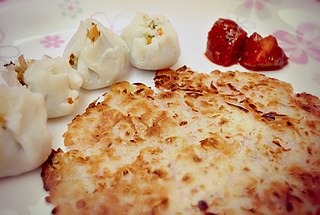
Sarva pindi is a savory, circular-shaped pancake made from rice flour and peanuts in Telangana, India. In the Nalgonda district, the item is known as "tappala chekka", while in Karimnagar it is most delicacy dish and also known as "sarva pindi". "Ganju" means utensil or a round shaped bowl and "pindi" means flour in Telugu language. So, the phrase "Ganju Pindi" can be described as rice flour that is made like atta flour and stick to the round shaped pan. In Warangal, the dish is known as "ginnappa". The village Bollepally in Warangal district is particularly famous for ginnappa, as the story about ginnappa first originated from the Challa Anasurya house in the village. A few years back, Anasurya was feeling very hungry in rainy season, but desired a new dish with less oil. As she had only rice flour in her home at the time, this led to the creation of the sarva pindi snack. She began to sell some in Bollepally village,Telangana district, With help of persons for some days like that entire Telugu people came to know about sarva pindi snack.

Telangana cuisine is a food culture unique to Telangana Region. The Telangana state lies on the Deccan plateau and its topography dictates more millets and roti based dishes. Jowar and Bajra features more prominently in their cuisine. Due to its proximity with Maharashtra, Chhattisgarh and northwest Karnataka, it shares some similarities and differences of the Deccan Plateau cuisine.
Are-Katika, Katika is the Khatik community from Telangana, Andhra pradesh and Karnataka states in India. In Northern part of the Country, they are known as khatiks. The traditional trade of this community is goat and sheep meat selling. They follow Hinduism and do not slaughter animals for halal meat, which can only be done by Muslim Qureshis. After the animal is slaughtered, they separate the skin and other parts from the carcass for selling as meat and its by-products. The women folk sell the by-products of goat and sheep in toddy shops. CHAKNA is a traditional delicacy prepared by the women with goat tripe and other animal digestive parts like intestines. CHAKNAWADI is a place named after this dish is in Begumbazar of Hyderabad (India), where maximum families of this community hail from. Most of them work as daily wage earners in Mandis for their livelihood. Though more than sixty percent of the Khatiks in Telangana still follow the profession of meat selling, they do not come under Scheduled Caste (SC) status by the Government of India and are categorized in Other Backward Classes. And Khatik's are known as kshtriya tribes who were assigned as soldiers of Maratha clan.

Acehnese cuisine is the cuisine of the Acehnese people of Aceh in Sumatra, Indonesia. This cuisine is popular and widely known in Indonesia. Arab, Persian, and Indian traders influenced food in Aceh although flavours have substantially changed their original forms. Combination of spices in Acehnese cuisine just as are commonly found in Indian and Arab cuisine, such as ginger, pepper, coriander, cumin, cloves, cinnamon, cardamom and fennel. A variety of Acehnese food is cooked with curry or coconut milk, which is generally combined with meat such as buffalo, beef, goat meat, lamb, mutton, fish, or chicken.
















